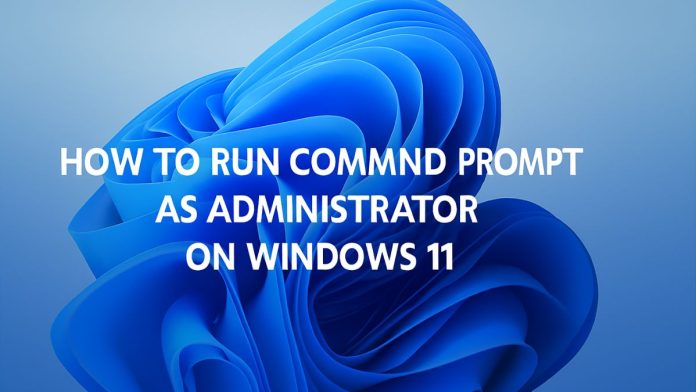Running Command Prompt as an administrator on Windows 11 is an essential task for users who need to perform advanced system functions, troubleshoot issues, or execute commands that require elevated privileges. While the standard Command Prompt allows for a range of basic tasks, administrative access unlocks powerful features that can manage system settings, configure networks, and manipulate files in protected directories. This elevated version is often referred to as an “elevated Command Prompt.”
Understanding the difference between a standard and an administrator Command Prompt can help prevent errors and improve efficiency when working with command-line tools. In this guide, you’ll learn various methods to access Command Prompt as an administrator, allowing you to take full control of your Windows 11 environment and perform tasks that otherwise would not be permitted under a regular user account.
Why Run Command Prompt as Administrator?
When you run Command Prompt with administrative privileges, you’re granted additional permissions to execute commands that require elevated rights. Some examples include:
- Modifying system files and settings
- Running advanced network commands (e.g.,
netsh) - Installing or removing system-wide applications
- Managing disk partitions with
diskpart - Resetting system components
Without administrative access, many commands will return an “Access Denied” error or will fail to execute properly.
Method 1: Using the Start Menu
- Click the Start button or press the Windows key on your keyboard.
- In the search bar, type
cmdor Command Prompt. - In the search results, right-click on Command Prompt.
- Select Run as administrator from the context menu.
- If prompted by User Account Control (UAC), click Yes.
This is the most straightforward and commonly used method to launch an elevated Command Prompt.
Method 2: Using the Run Dialog Box
- Press Windows + R to open the Run dialog.
- Type
cmdinto the text box. - Instead of pressing Enter, press Ctrl + Shift + Enter.
- Confirm the UAC prompt by clicking Yes.
This keyboard shortcut is a quick way to launch CMD with administrator privileges without going through the Start menu.
Method 3: Using Task Manager
- Press Ctrl + Shift + Esc to open Task Manager.
- Click File in the top-left corner, then choose Run new task.
- In the dialog box that appears, type
cmd. - Check the box that says Create this task with administrative privileges.
- Click OK.
This method is particularly useful when other parts of the system interface are not responding or accessible.
Method 4: Using Windows Terminal
Windows 11 comes with Windows Terminal, which supports Command Prompt, PowerShell, and other shells.
- Click the Start button and search for Windows Terminal.
- Right-click on it and choose Run as administrator.
- In the terminal, click the downward-facing arrow in the title bar.
- Select Command Prompt from the list of profiles.
Alternatively, if Command Prompt is your default profile in Terminal, it will open automatically.
Method 5: From File Explorer
- Open File Explorer using Windows + E.
- Navigate to the following location:
C:\Windows\System32 - Scroll down and find
cmd.exe. - Right-click on it and select Run as administrator.
- Confirm the UAC prompt.
You can also create a desktop shortcut to cmd.exe from this location.
Method 6: Creating a Shortcut to Always Run as Administrator
- Right-click on your desktop and choose New > Shortcut.
- In the location field, type:
C:\Windows\System32\cmd.exe - Click Next, name your shortcut (e.g., “Admin CMD”), and click Finish.
- Right-click the new shortcut and choose Properties.
- Under the Shortcut tab, click Advanced.
- Check the box labeled Run as administrator.
- Click OK, then Apply, and OK again.
From now on, double-clicking this shortcut will always launch Command Prompt with elevated privileges.
Method 7: Using Keyboard Shortcuts in the Start Menu
- Press the Windows key and search for Command Prompt.
- Use the arrow keys to highlight it.
- Press Ctrl + Shift + Enter.
- Click Yes on the UAC prompt.
This is a fast way to launch elevated CMD without using the mouse.
How to Confirm Command Prompt Is Running as Administrator
When CMD is running with administrative privileges, the title bar will say “Administrator: Command Prompt”. You can also run the following command to check your permissions:
net sessionIf it returns information without errors, you are running as an administrator. If it returns “Access is denied,” then you’re not.
Troubleshooting Tips
- UAC Not Prompting? Make sure User Account Control is enabled in Control Panel > User Accounts > Change User Account Control settings.
- Error: Access Denied? Double-check that you’re launching CMD with elevated privileges.
- Can’t find CMD in search? Type the full name “Command Prompt” instead of just “cmd”.
Security Considerations
Running Command Prompt as an administrator grants powerful control over your system. Be cautious with the commands you run:
- Do not execute unfamiliar scripts or commands without verifying them.
- Avoid using elevated CMD unless necessary.
- Regular users should be prevented from accessing elevated tools in shared or business environments.
Bonus: Open Admin CMD at Startup or with a Task
You can use Task Scheduler to automatically open Command Prompt with administrator privileges at login or on specific triggers:
- Open Task Scheduler from Start.
- Click Create Task (not Basic Task).
- Under the General tab:
- Name the task (e.g., “Admin CMD”)
- Check Run with highest privileges
- Go to the Triggers tab and click New.
- Choose At log on or another preferred option.
- Go to the Actions tab, click New:
- Action: Start a program
- Program/script:
cmd.exe
- Click OK to save and exit.
This will launch Command Prompt as administrator automatically when your chosen trigger occurs.
Conclusion
Knowing how to run Command Prompt as an administrator on Windows 11 is essential for any user who wants full control over their system. With administrative access, you can perform advanced diagnostics, tweak system settings, and run commands that would otherwise be restricted.
Whether you’re a casual user trying to troubleshoot a problem or an IT professional managing multiple systems, mastering these methods ensures you’re equipped to use CMD efficiently and securely. By choosing the approach that best fits your workflow, you can streamline administrative tasks and maintain greater control over your Windows environment.


![How to Use WhatsApp Web? [Beginners Friendly] how-to-use-whatsapp-web-thumb](https://www.internetoutsider.com/wp-content/uploads/2025/05/how-to-use-whatsapp-web-thumb-218x150.jpg)




